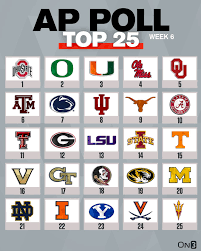College Football: The Influence and Evolution of the AP Poll
The Associated Press Poll, commonly known as the AP Poll, has been a cornerstone of college football rankings since its inception in November 1936. Its origins trace back to the 1930s, when sportswriters began conducting informal polls to determine the nation’s top teams. The poll was officially created by Charles Sherman after a controversial three-way tie for the national championship between Minnesota, Princeton, and Southern Methodist. Minnesota fans protested the outcome, prompting the need for a more standardized ranking system. Since then, the AP Poll has earned trust through its consistency and longevity, becoming a key measure of success in college football.
Each week during the season, 62 national sportswriters and broadcasters—selected by the Associated Press—submit their rankings of the top 25 teams. These voters are considered experts, chosen for their extensive experience covering college football across various regions. A point system determines the rankings: a first-place vote earns 25 points, second place earns 24, and so on.
The AP Poll is dynamic, shifting weekly based on game outcomes, voter perspectives, and fan reactions. Upsets—especially when a top-ranked team loses to a lower-ranked or unranked opponent—can cause major shake-ups. Fans are deeply invested in the poll, as it reflects national perception and influences playoff hopes.
Being ranked in the AP Poll has significant implications. Teams must maintain strong performances to stay in contention for the 12-team College Football Playoff. A consistent ranking also boosts recruiting, as high school athletes are drawn to successful programs. Additionally, ranked teams are more likely to receive invitations to prestigious bowl games, even though six wins guarantee bowl eligibility. The higher the ranking, the better the bowl placement and exposure.
Despite its importance, the AP Poll faces criticism. Concerns include regional bias, preseason rankings, and limited voter coverage. Teams from powerhouse conferences like the SEC and Big Ten often dominate the poll, while Group of Five schools struggle for recognition. Voters typically focus on games within their assigned regions—Northeast, Midwest, Southeast—which can lead to reliance on reputation and conference prestige rather than actual performance.
Historically, the AP Poll played a central role in determining national champions before the College Football Playoff (CFP) system was introduced. While the CFP committee now decides playoff participants, the AP Poll still shapes early-season narratives and influences public perception before the first CFP rankings are released. Though it no longer decides championships, it remains a respected tradition and a source of pride for programs and players.
Fans continue to voice strong opinions about the AP Poll. Kayde Ridley commented, “There are lots of teams that are undeserving—not just being in the top 25, but where they’re placed in general.” He acknowledged the poll’s week-to-week logic but believes it needs improvement to better align with the playoff format. Still, he supports keeping it as part of the sport.
Cooper McCutchan shared similar sentiments, saying, “Seeing Missouri makes me mad,” and arguing that Vanderbilt is ranked too low despite being one of the best teams in the SEC. He felt Texas was overrated, claiming, “They haven’t played anyone,” and pointed to their loss to Ohio State as proof. Cooper also believed Penn State was ranked too high and that Notre Dame deserved a spot despite two losses, given their tough schedule. Both agreed the poll isn’t always accurate, with Cooper noting that voters often only watch top games and overlook others.
In the end, the AP Poll remains a vital part of college football’s culture—sparking debate, driving fan engagement, and honoring tradition. While not perfect, it continues to shape the sport in meaningful ways.

